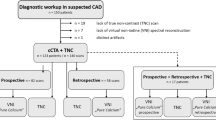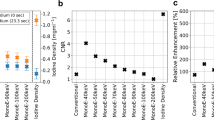Abstract
Noninvasive coronary angiography has been the holy grail of cardiovascular medicine for decades. Cardiac CT angiography obtained with multislice CT technology is finally reaching the high standard in spatial resolution that is achieved by invasive X-ray coronary angiography. The latest 64-slice CT technology is a fast and safe modality for imaging the heart and coronary arteries, with scans taking seconds to complete. The temporal resolution of cardiac CT is still inferior, however, to that of invasive angiography, echocardiography or cardiac MRI. As such, this technique is still highly susceptible to motion artifacts created by the beating heart, and blooming artifacts due to the presence of calcium in the atherosclerotic plaque and to metallic implants. The routine use of agents to lower the heart rate before scanning is still required in most patients, and the timing of the contrast injection is critical for obtaining high-quality diagnostic cardiac images. Furthermore, cardiac CT angiography exposes the patient to substantial amounts of ionizing radiation and nephrotoxic contrast agents and, therefore, patients must be carefully selected based on a thorough understanding of the current clinical indications. In this review, I discuss the current multidetector row CT technology, safety issues, imaging protocols, clinical applications, and some of the challenges that still lie ahead with this modality.
Key Points
-
An accurate, noninvasive angiographic technique is required to image the heart and coronary arteries, and multislice CT technology seems likely to meet this need
-
Currently, the spatial resolution achievable with multidetector row CT is around 0.4 mm, although this temporal resolution is still inferior to those achieved with invasive angiography, echocardiography or cardiac MRI
-
To obtain the best-quality images, agents to slow heart rate should be used to minimize motion artifacts due to the beating of the heart, and administration of the contrast agent should be carefully timed
-
Electrocardiography-controlled dose modulation can be used to minimize radiation exposure; current doses are 7.45 mSv for men and 10.25 mSv for women with 64-slice multidetector row CT
-
Cardiac CT angiography is likely to become an important part of noninvasive cardiac imaging for cardiologists and radiologists, although more outcome studies are needed to assess its role fully
This is a preview of subscription content, access via your institution
Access options
Subscribe to this journal
Receive 12 print issues and online access
$209.00 per year
only $17.42 per issue
Buy this article
- Purchase on Springer Link
- Instant access to full article PDF
Prices may be subject to local taxes which are calculated during checkout









Similar content being viewed by others
References
Ammann P et al. (2003) Procedural complications following diagnostic coronary angiography are related to the operators experience and the catheter size. Catheter Cardiovasc Interv 59: 13–18
Budoff MJ et al. (2003) Clinical utility of computed tomography and magnetic resonance techniques for noninvasive coronary angiography. J Am Coll Cardiol 42: 1867–1878
Fayad ZA et al. (2002) Computed tomography and magnetic resonance imaging for noninvasive coronary angiography and plaque imaging: current and potential future concepts. Circulation 106: 2026–2034
Wagner A et al. (2003) Contrast-enhanced MRI and routine single photon emission computed tomography (SPECT) perfusion imaging for detection of subendocardial myocardial infarcts: an imaging study. Lancet 361: 374–379.
Nieman K et al. (2002) Reliable noninvasive coronary angiography with fast submillimeter multislice spiral computed tomography. Circulation 106: 2051–2054
Ropers D et al. (2003) Detection of coronary artery stenoses with thin-slice multi-detector row spiral computed tomography and multiplanar reconstruction. Circulation 107: 664–666
Kuettner A et al. (2004) Noninvasive detection of coronary lesions using 16-detector multislice spiral computed tomography technology—initial clinical results. J Am Coll Cardiol 44: 1230–1237
Mollet NR et al. (2004) Multislice spiral computed tomography coronary angiography in patients with stable angina pectoris. J Am Coll Cardiol 43: 2265–2270
Martuscelli E et al. (2004) Accuracy of thin-slice computed tomography in the detection of coronary stenoses. Eur Heart J 25: 1043–1048
Hoffmann U et al. (2004) Predictive value of 16-slice multidetector spiral computed tomography to detect significant obstructive coronary artery disease in patients at high risk for coronary disease: patient-versus segment-based analysis. Circulation 110: 2638–2643
Kuettner A et al. (2005) Diagnostic accuracy of noninvasive coronary imaging using 16-detector multislice spiral computed tomography with 188 ms temporal resolution. J Am Coll Cardiol 45: 123–127
Mollet NR et al. (2005) Improved diagnostic accuracy with 16-row multi-slice computed tomography coronary angiography. J Am Coll Cardiol 45: 128–132
Hoffmann MH et al. (2005) Noninvasive coronary angiography with multislice computed tomography. JAMA 293: 2471–2478
Sanz J et al. (2005) The importance of end-systole for optimal reconstruction protocol of coronary angiography with 16-slice multidetector computed tomography. Invest Radiol 40: 155–163
Hunold P et al. (2003) Radiation exposure during cardiac CT: effective doses at multi-detector row CT and electron-beam CT. Radiology 226: 145–152
Mozaffarian D (2005) Electron-beam computed tomography for coronary calcium: a useful test to screen for coronary heart disease? JAMA 294: 2897–2901
Morin RL et al. (2003) Radiation dose in computed tomography of the heart. Circulation 107: 917–922
Jakobs TF et al. (2002) Multislice helical CT of the heart with retrospective ECG gating: reduction of radiation exposure by ECG-controlled tube current modulation. Eur Radiol 12: 1081–1086
Ropers D et al. (2006) Usefulness of multidetector row computed tomography with 64- × 0.6-mm collimation and 330-ms rotation for the noninvasive detection of significant coronary artery stenoses. Am J Cardiol 97: 343–348
Leta R et al. (2004) Non-invasive coronary angiography with 16 multidetector-row spiral computed tomography: a comparative study with invasive coronary angiography. Rev Esp Cardiol 57: 217–224
Nieman K et al. (2003) Evaluation of patients after coronary artery bypass surgery: CT angiographic assessment of grafts and coronary arteries. Radiology 229: 749–756
Martuscelli E et al. (2004) Evaluation of venous and arterial conduit patency by 16-slice spiral computed tomography. Circulation 110: 3234–3238
Schlosser T et al. (2004) Noninvasive visualization of coronary artery bypass grafts using 16-detector row computed tomography. J Am Coll Cardiol 44: 1224–1229
Femelden D et al. (2000) Anomalous coronary arteries of aortic origin. Int J Clin Pract 54: 390–394?
Boulmier D et al. (2003) Sudden death disclosing abnormal origin of the left coronary vessel from the pulmonary artery trunk. Arch Mal Coeur Vaiss 96: 135–139
De Luca L et al. (2004) Congenital coronary artery anomaly simulating an acute aortic dissection. Heart 90: e11
Angelini P et al. (2002) Coronary anomalies: incidence, pathophysiology, and clinical relevance. Circulation 105: 2449–2454
Datta J et al. (2005) Anomalous coronary arteries in adults: depiction at multi-detector row CT angiography. Radiology 235: 812–818
Ropers D et al. (2001) Visualization of coronary artery anomalies and their course by contrast-enhanced electron beam tomography and three-dimensional reconstruction. Am J Cardiol 87: 193–197
Deibler AR et al. (2004) Imaging of congenital coronary anomalies with multislice computed tomography. Mayo Clin Proc 79: 1017–1023
Lessick J et al. (2004) Anomalous origin of a posterior descending artery from the right pulmonary artery: report of a rare case diagnosed by multidetector computed tomography angiography. J Comput Assist Tomogr 28: 857–859
Reiter SJ et al. (1986) Precision of measurements of right and left ventricular volume by cine computed tomography. Circulation 74: 890–900
Pietras RJ et al. (1991) Validation of ultrafast computed tomographic left ventricular volume measurement. Invest Radiol 26: 28–34
Feiring AJ et al. (1988) Sectional and segmental variability of left ventricular function: experimental and clinical studies using ultrafast computed tomography. J Am Coll Cardiol 12: 415–425
Juergens KU et al. (2002) Using ECG-gated multidetector CT to evaluate global left ventricular myocardial function in patients with coronary artery disease. AJR Am J Roentgenol 179: 1545–1550
Mahnken AH et al. (2003) Quantitative and qualitative assessment of left ventricular volume with ECG-gated multislice spiral CT: value of different image reconstruction algorithms in comparison to MRI. Acta Radiol 44: 604–611
Wood MA et al. (2004) A comparison of pulmonary vein ostial anatomy by computerized tomography, echocardiography, and venography in patients with atrial fibrillation having radiofrequency catheter ablation. Am J Cardiol 93: 49–53
Lacomis JM et al. (2003) Multi-detector row CT of the left atrium and pulmonary veins before radio-frequency catheter ablation for atrial fibrillation. Radiographics 23 (Spec No): S35–S48
Nikolaou K et al. (2005) Assessment of myocardial perfusion and viability from routine contrast-enhanced 16-detector-row computed tomography of the heart: preliminary results. Eur Radiol 15: 864–871
Achenbach S et al. (2005) Detection of coronary artery stenoses using multi-detector CT with 16 × 0.75 collimation and 375 ms rotation. Eur Heart J 26: 1978–1986
Kuettner A et al. (2005) Image quality and diagnostic accuracy of non-invasive coronary imaging with 16 detector slice spiral computed tomography with 188 ms temporal resolution. Heart 91: 938–941
Cademartiri F et al. (2005) Usefulness of multislice computed tomographic coronary angiography to assess in-stent restenosis. Am J Cardiol 96: 799–802
Kaiser C et al. (2005) Limited diagnostic yield of non-invasive coronary angiography by 16-slice multidetector spiral computed tomography in routine patients referred for evaluation of coronary artery disease. Eur Heart J 26: 1987–1992
Kefer J et al. (2005) Head-to-head comparison of three-dimensional navigator-gated magnetic resonance imaging and 16-slice computed tomography to detect coronary artery stenosis in patients. J Am Coll Cardiol 46: 92–100
Mollet NR et al. (2005) Noninvasive assessment of coronary plaque burden using multislice computed tomography. Am J Cardiol 95: 1165–1169
Leschka S et al. (2005) Accuracy of MSCT coronary angiography with 64-slice technology: first experience. Eur Heart J 26: 1482–1487
Raff GL et al. (2005) Diagnostic accuracy of noninvasive angiography using 64-slice spiral computed tomography. J Am Coll Cardiol 46: 552–557
Mollet NR et al. (2005) High-resolution spiral computed tomography coronary angiography in patients referred for diagnostic conventional coronary angiography. Circulation 112: 2318–2323
Pugliese F et al. (2005) Diagnostic accuracy of non-invasive 64-slice CT coronary angiography in patients with stable angina pectoris. Eur Radiol 16: 1–8
Leber AW et al. (2005) Quantification of obstructive and nonobstructive coronary lesions by 64-slice computed tomography: a comparative study with quantitative coronary angiography and intravascular ultrasound. J Am Coll Cardiol 46: 147–154
Author information
Authors and Affiliations
Corresponding author
Ethics declarations
Competing interests
The author declares no competing financial interests.
Rights and permissions
About this article
Cite this article
Poon, M. Technology Insight: cardiac CT angiography. Nat Rev Cardiol 3, 265–275 (2006). https://doi.org/10.1038/ncpcardio0541
Received:
Accepted:
Issue Date:
DOI: https://doi.org/10.1038/ncpcardio0541
This article is cited by
-
Discrepancies between coronary CT angiography and invasive coronary angiography with focus on culprit lesions which cause future cardiac events
European Radiology (2018)
-
Coronary CT Angiography in Patients with Atrial Fibrillation
Current Cardiovascular Imaging Reports (2014)



